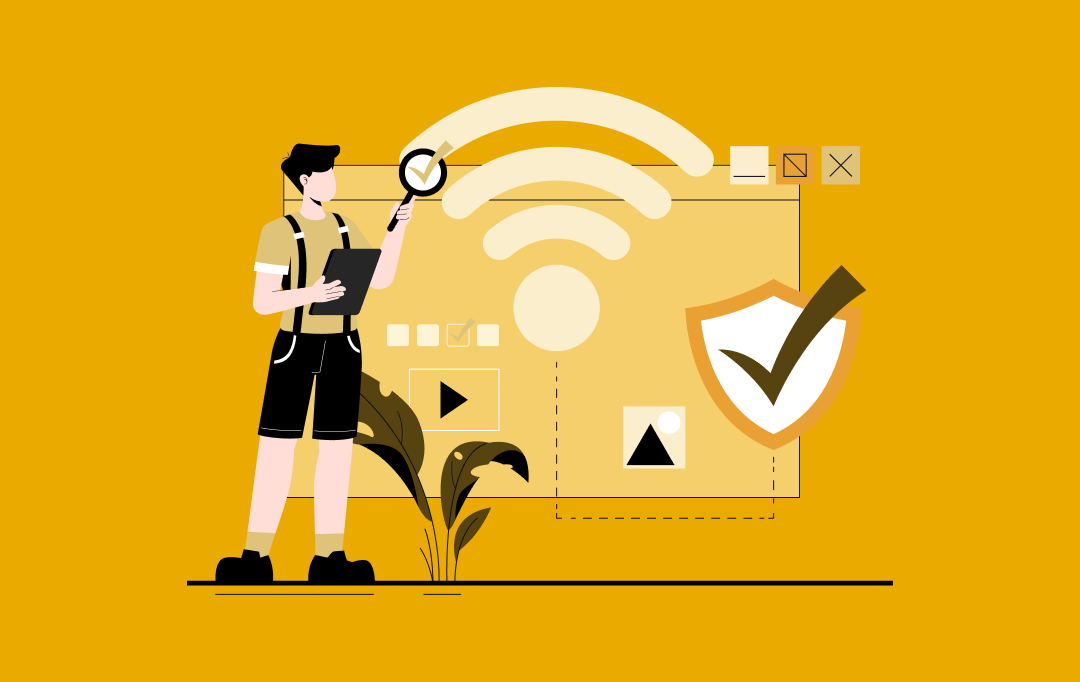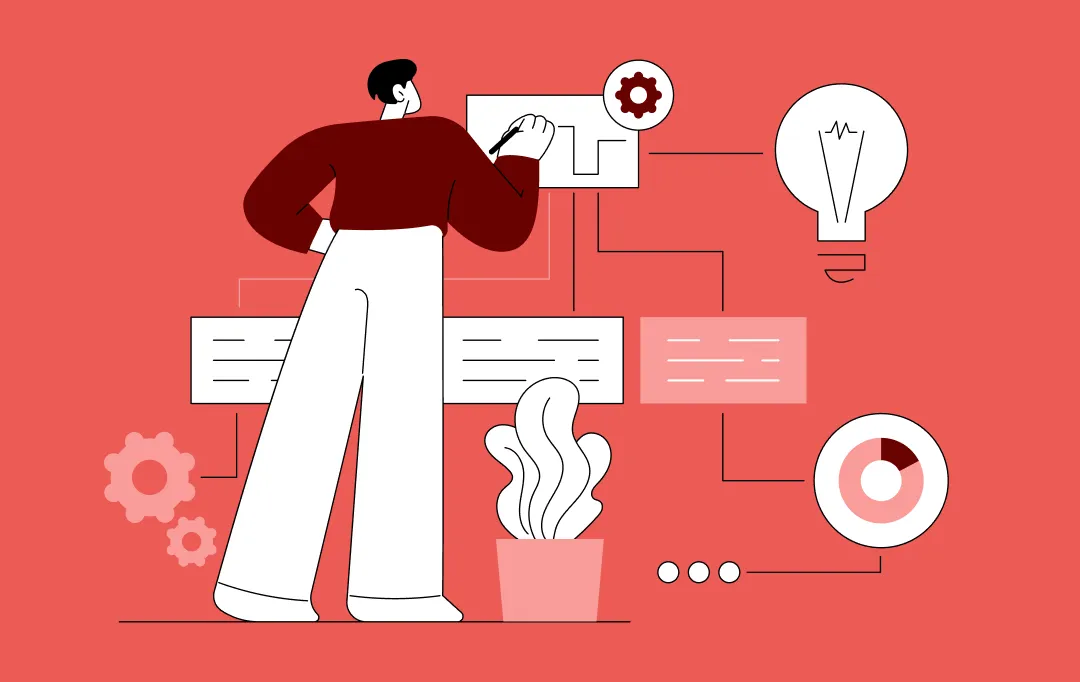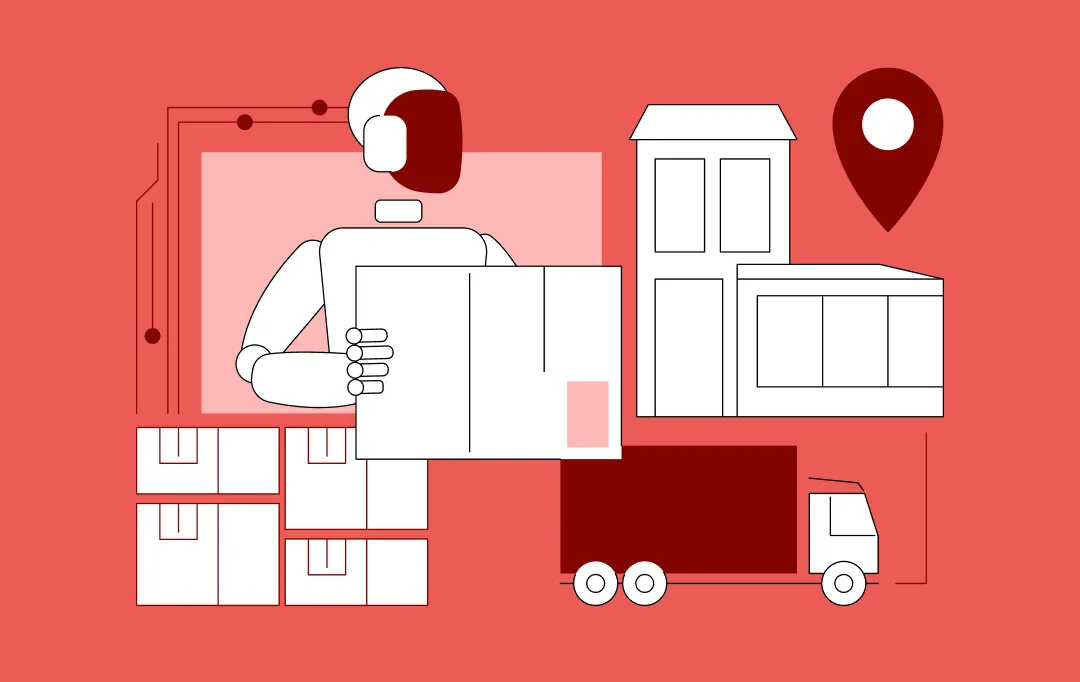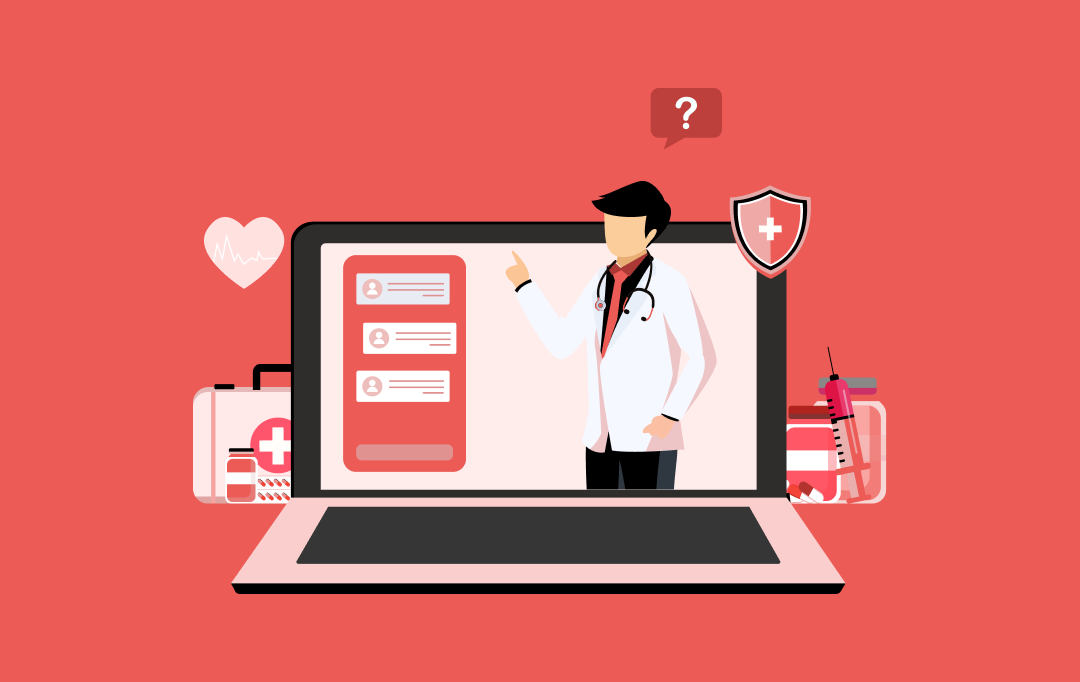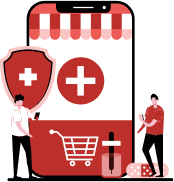- Why Telepharmacy Software Matters
- How a Telepharmacy App Works
- Types of Telepharmacy Software Solutions
- Online Consultation Centres
- Telepharmacy Managing Systems
- Remote Prescription Verifying System
- Patient-Facing and Mobile Applications
- Analytics and Reporting Tools
- Automated Dispensing Solutions
- Key Features of Telepharmacy Software
- Benefits of Telepharmacy in Improving Patient Health Care
- Access to Pharmacy Services
- Better Medication Adherence
- Enhanced Patient Safety
- Cost and Time Efficiency
- Healthcare Systems Integration
- Assistance in Chronic Disease Management
- Healthcare Provider Scalability
- Practical Telepharmacy Software Use Cases in Modern Healthcare With Real-Life Examples
- Distant Prescription Checking
- Medication Counseling and Patient Education
- Chronic Diseases Drug Management
- Centralized Pharmacy Operations
- After-Hours and Emergency Assistance
- Telepharmacy Software Development Journey
- Requirement Gathering and Analysis
- System Architecture and Design
- Development and Integration
- Quality Assurance and Testing
- Deployment and Training
- Constant Updates and Support
- Critical Challenges in Building Telepharmacy Software and Strategies to Solve Them
- Regulatory Compliance
- Information Security and Patient Confidentiality
- Interoperability with Existing Systems
- User Adoption and Training
- Scalability and Performance
- Build a Reliable Telepharmacy Platform with Appinventiv
- FAQs
Key Takeaways
- Telepharmacy software enables healthcare providers to deliver pharmacy services directly to patients in remote and underserved areas. Essentially, it breaks down those geographic barriers.
- The automated tools in these platforms accomplish several tasks simultaneously: they enhance medication safety, significantly increase patient adherence to prescriptions, and streamline daily pharmacy operations for improved efficiency.
- The system integrates with electronic health records and billing platforms so that the pharmacists can see all patient information and manage their entire workflow smoothly.
- Custom telepharmacy solutions help healthcare organizations scale up their services. They reduce operational costs while keeping a high standard of patient care steady across every location.
Access to pharmacy services on time is still a major problem for a lot of patients, especially people living in rural areas or places that don’t have enough healthcare resources. In the U.S., more than 48 million people live in areas where accessing a pharmacy requires a long drive. About 1 in 7 Americans are in what researchers call “pharmacy deserts” (Source: GoodRx). When people can’t reach a pharmacy easily, it leads to medication mistakes, patients not taking their prescriptions correctly, and worse health results overall.
Telepharmacy software is changing how healthcare gets delivered. It enables pharmacists to conduct consultations, verify prescriptions, and provide counseling to patients without being in the same room. This digital setup enables patients to receive pharmaceutical care when needed, regardless of their location.
While developing telepharmacy platforms, the focus should be on building secure digital tools that are easy to use. These platforms connect patients with pharmacists and healthcare facilities. They make things safer, help patients stick to their medication schedules, and cut down on errors. Hospitals, clinics, and retail pharmacies are adopting these digital solutions more and more. Telepharmacy has become a vital component that healthcare systems can no longer afford to overlook.
If you want to build a telepharmacy platform that works well, there’s a lot of planning involved. Businesses must consider regulatory requirements and ensure that the software integrates seamlessly with existing pharmacy management systems. The workflows need to be designed so pharmacists and healthcare providers can collaborate without friction.
Features range from managing prescriptions to tracking whether patients are taking their medications and offering virtual counseling sessions. Each telepharmacy software function or role is built with patient outcomes in mind.
This guide goes into why telepharmacy software development matters, how it works, its types, key features, benefits, use cases with real-life examples, development process, and critical adoption challenges with solutions. Let’s dive deeper.
Step into the future of healthcare with telepharmacy software that ensures continuous pharmacy services for every suburb
Why Telepharmacy Software Matters
Pharmacy services are becoming accessible, accurate, and more efficient with the use of telepharmacy software. It addresses issues such as sluggish prescription reviews, medication errors, and chronic conditions management gaps that are most poignant in the rural setting or areas with insufficient health care coverage. The pharmacists will be able to make a consultation, review prescriptions, and speak to patients remotely.
The platforms allow providing safer and quicker healthcare. The applications of telepharmacy software continue to grow. You have virtual consultations, prescription checks, stocking management, and devices that check the actual consumption of the medications by patients.
Telepharmacy has become so significant that its figures in the market are impressive. The Global Telepharmacy Market is projected to reach $32.93 billion by 2030, growing between 2025 and 2030. (Source: Mordor Intelligence)
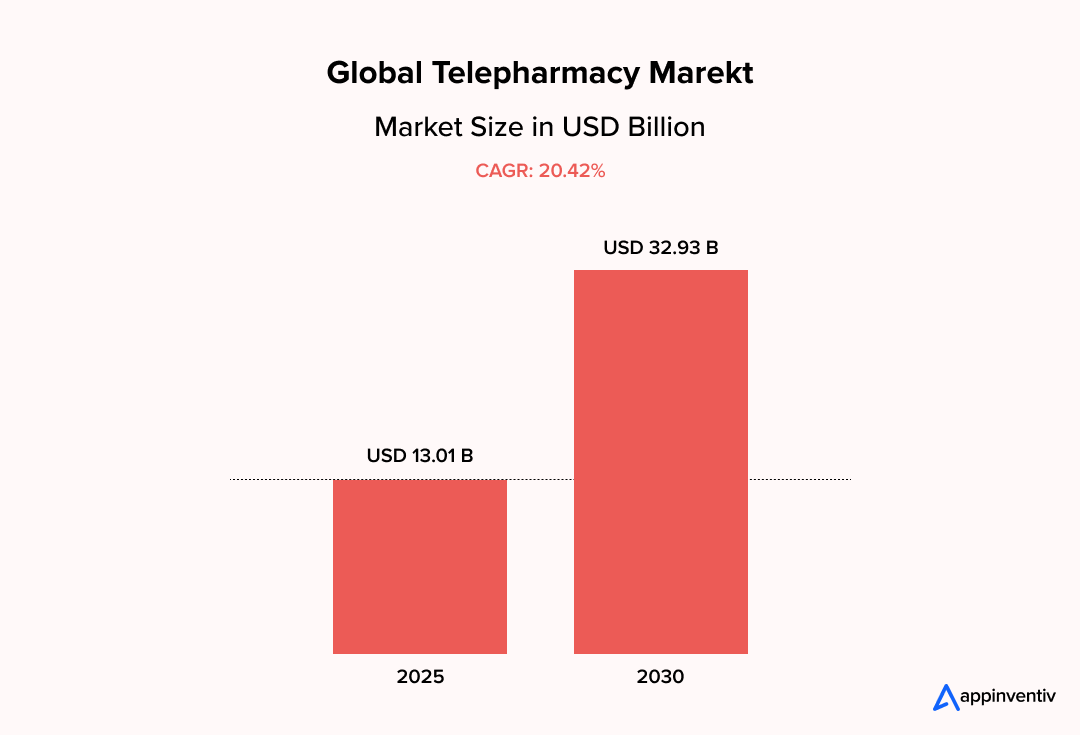
What’s pushing this growth? There is an increasing number of healthcare systems that are going digital. Chronic diseases are increasing. Areas that are remote lack sufficient pharmacists. And there is an actual need for both efficient and compliant medication management.
Developing a robust telepharmacy platform requires careful attention to every stage of the Telepharmacy software development lifecycle. Begin with the planning and ensure that you are abiding by the requirements of the regulations. Then, target integration with current pharmacy management systems. Monitor the performance of things after launch. All of the phases are important since they guarantee a platform that provides high-quality, seamless, and safe pharmacy services.
How a Telepharmacy App Works
A telepharmacy application is a digital workflow between patients, pharmacists, and healthcare providers with the help of a secure application. It simplifies the process of prescription review, verification, dispensing, and monitoring, and enables pharmacists to provide their services beyond the traditional physical locations.
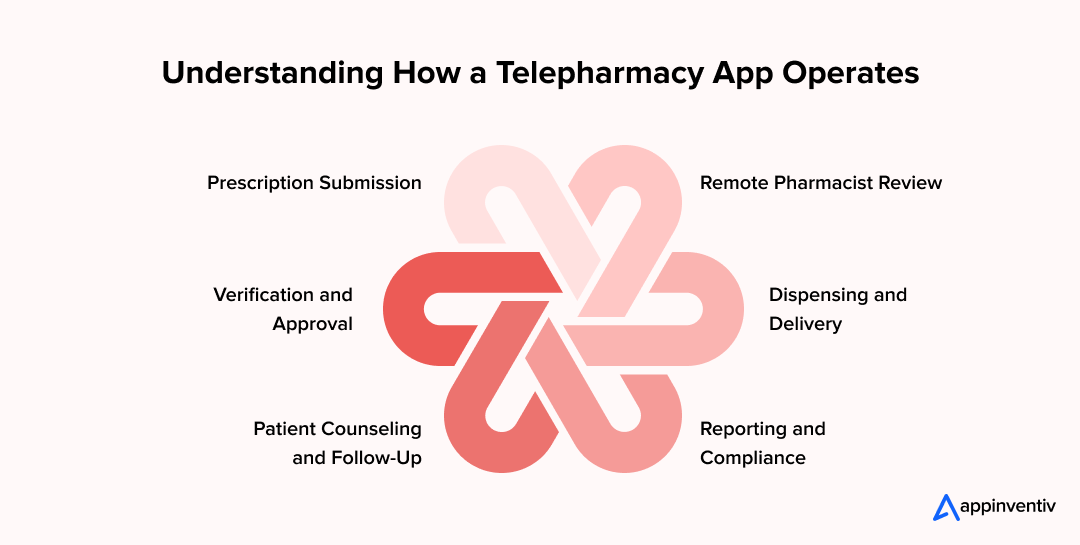
Prescription Submission: The app has a prescription tool that allows patients or physicians to upload a prescription, which is then transferred to a licensed pharmacist in a secure manner. This initial action would help to guarantee that all medication orders are recorded and can be tracked in a compliant electronic system.
Remote Pharmacist Review: The pharmacist retrieves the prescription, examines the dosage, has a look at the possible interaction, and identifies the patient. In case of any confusion, the pharmacist can talk to the prescribing physician using video communication or real-time chat.
Verification and Approval: The prescription is approved using the platform by the pharmacist after verification. A notification is sent to the connected pharmacy in order to start dispensing, so that the process is fast and free of errors.
Dispensing and Delivery: The pharmacy fulfills the approved order and loads it up for pick-up or doorstep delivery. Some of them are automated dispensing units or partner pharmacies, which complete this step to ensure that medication access can be faster and more reliable.
Patient Counseling and Follow-Up: Pharmacists offer online consultations via video calls or chats, recommending to patients how they should take medication, side effects, and lifestyle features. This measure serves to strengthen compliance and create confidence in the patient.
Reporting and Compliance: All activities are automatically recorded as a quality assurance and control measure and for regulatory reporting. Dashboards provide pharmacy managers and healthcare administrators with the opportunity to monitor the performance, detect trends, and ensure that local healthcare standards are observed.
Types of Telepharmacy Software Solutions
Telepharmacy software is available in different forms, all aimed at overseeing the operations and the circumstances of patient care. The knowledge of these kinds assists the healthcare professionals in choosing the appropriate solution for their workflow.
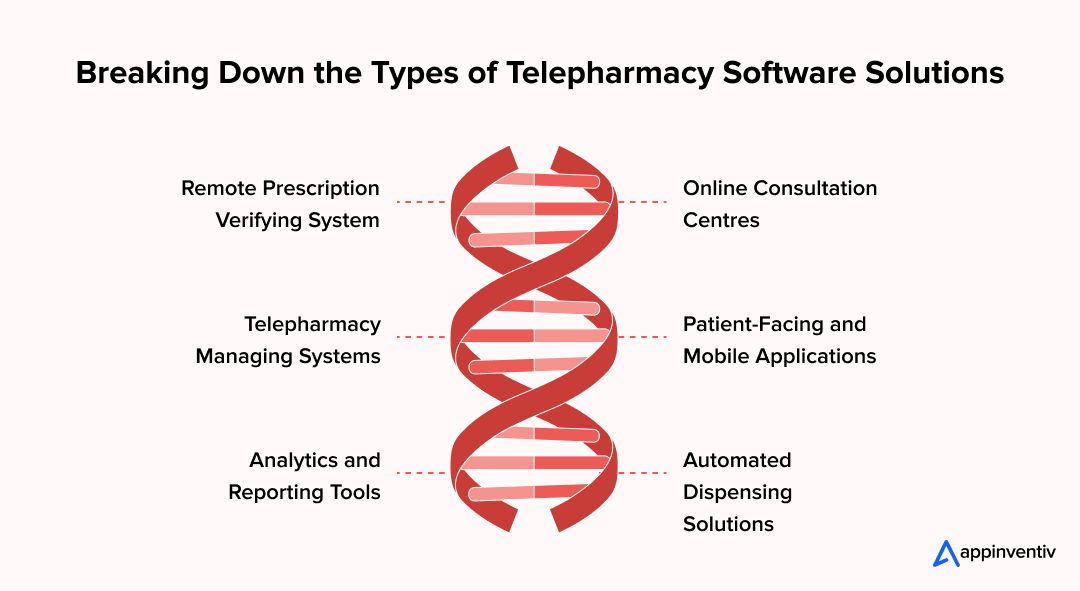
Online Consultation Centres
This kind allows patients to discuss with pharmacists via video calls, chat, and messaging. It helps in counseling of medications, chronic illnesses monitoring, and educating patients, and helps in bridging the gap between patients and health care providers.
Telepharmacy Managing Systems
These end-to-end systems integrate prescription, virtual consultation, tracking, reporting, and compliance software. They are perfect in hospitals, retail chains, or in a multi-location healthcare provider that needs to have a single management.
Remote Prescription Verifying System
With these platforms, pharmacists can be in different locations and view and approve prescriptions, which guarantees accuracy and conformity. They come in handy, especially when there is a shortage of on-site pharmacists in rural or underserved regions.
Also Read: The GoodRx App Development Cost: Insights and Analysis
Patient-Facing and Mobile Applications
Patient apps assist in drug reminders, refills, as well as immediate interactions with pharmacists. They increase compliance, participation, and accessibility, increasing the general health outcomes.
Analytics and Reporting Tools
There are telepharmacy software solutions concentrating on the results of prescription data, adherence patterns, and operational outcomes. Those solutions help to use the data to make decisions and constantly improve the pharmacy services.
Automated Dispensing Solutions
These systems integrate with pharmacy inventory to automate dispensing and track medication stock levels. They help reduce errors, prevent shortages, and streamline daily pharmacy operations.
Key Features of Telepharmacy Software
Telepharmacy systems are developed to be able to bring pharmacy experience closer to patients without losing safety and efficiency. Their processes streamline clinical, operational, and administrative processes such that pharmacists can provide quality care at any location.
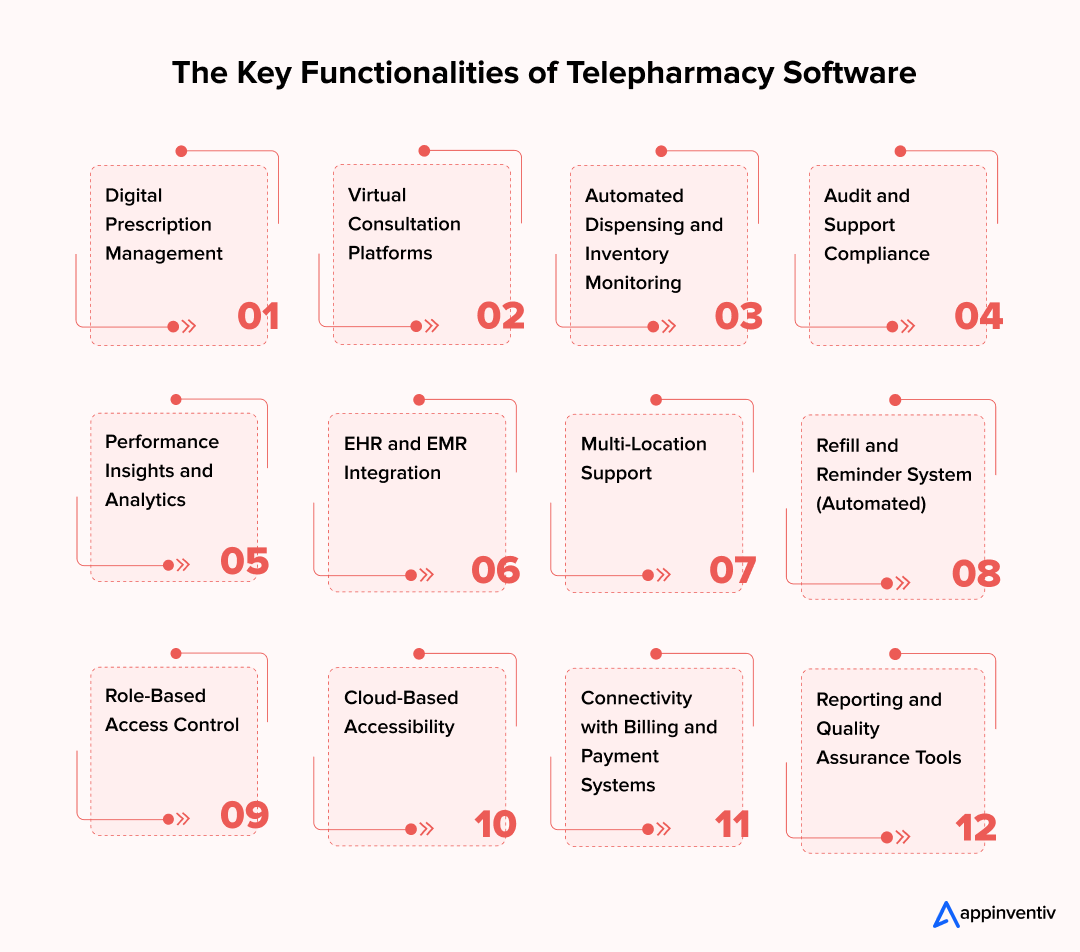 1. Digital Prescription Management: Encryption and access controls also provide advanced encryption and access control of the transmission and storage of prescriptions. Pharmacists are capable of checking, amending, and accepting prescriptions at a distance whilst retaining the ability to comply fully with regulatory regulations.
1. Digital Prescription Management: Encryption and access controls also provide advanced encryption and access control of the transmission and storage of prescriptions. Pharmacists are capable of checking, amending, and accepting prescriptions at a distance whilst retaining the ability to comply fully with regulatory regulations.
2. AI-Powered Virtual Consultation: The video calls and messaging functions will enable pharmacists to have real-time consultations with patients and clinicians, which will facilitate more effective communication and compliance.
3. Automated Dispensing and Inventory Monitoring: The system is connected to dispensing units and stock databases to track drug availability, drug expiry dates, and drug dispensing history to avoid any mistakes, and supplies are available throughout.
4. Audit and Support Compliance: Extensive audit history, electronic signatures, and regulation templates make documenting easier and complying with pharmacy and healthcare-related regulations.
5. Performance Insights and Analytics: The data dashboards offer insight into the number of prescriptions, medication compliance, medication use, and service quality, assisting the decision-makers in streamlining operations.
6. EHR and EMR Integration: The telepharmacy software package can be interconnected with the electronic health and medical records so that the patient history and treatment data can be accessed simultaneously, and proper medication reviews can be conducted.
7. Multi-Location Support: The prescriptions, consultations, and inventory can be handled by using the centralized control panels by the pharmacies conducting their operations in a number of branches or hospitals.
8. Refill and Reminder System (Automated): The use of smart scheduling makes patients more conscious of refills and dose times, decreases non-compliance, and enhances the success of long-term treatment.
9. Role-Based Access Control: Granular permissions enable the administrator to set up the role of users, guarding sensitive patient data without any issues in internal collaboration.
10. Cloud-Based Accessibility: The software is hosted on secure cloud infrastructure and promotes remote access to pharmacists so that they can provide 24/7 services without relying on local computing hardware.
11. Connectivity with Billing and Payment Systems: Digital payment modules and automated billing make transactions easier for patients and pharmacies and decrease the paperwork, and enhance revenue tracking.
12. Reporting and Quality Assurance Tools: In-built reporting systems provide comprehensive compliance, performance, and patient satisfaction reports, and facilitate ongoing enhancement of telepharmacy activities.
Appinventiv’s Insights
Take advantage of advanced features like AI-driven alerts, automated drug interaction checks, and integrated patient dashboards. These tools help pharmacists make faster, safer decisions, personalize counseling, and maintain high standards of care even when managing multiple patients remotely.
Benefits of Telepharmacy in Improving Patient Health Care
Telepharmacy is transforming the way pharmacy services are being provided and enhancing accessibility, efficiency, and patient outcomes. Telepharmacy can enhance care delivery, and the following are the benefits:
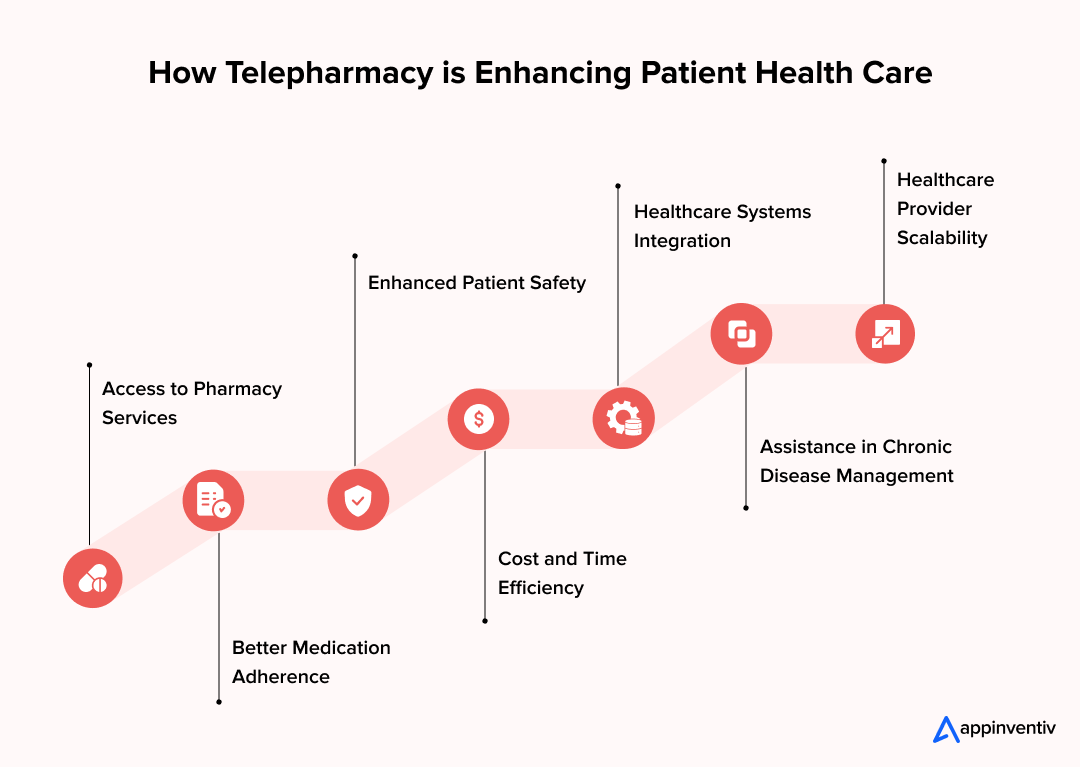
Access to Pharmacy Services
Telepharmacy eliminates geographic barriers, which means that patients in remote or underserved areas can reach competent pharmacists. With the help of the telepharmacy software development services, the healthcare providers can roll out platforms that provide real-time consultations, prescription reviews, and medication guidance to allow patients to receive timely care irrespective of their location.
Better Medication Adherence
The use of digital tools like automated reminders, dose notifications, and follow-up reminders can enable patients to be on schedule with medications. The presence of the features is guaranteed by a telepharmacy software development company, which incorporates them into the platform so that patients remain adherent and their compliance is monitored by pharmacists remotely.
Enhanced Patient Safety
Telepharmacy helps pharmacists to consult prescriptions, detect possible drug interactions, and give customized guidance. Including these features in the telepharmacy software development lifecycle would guarantee that the patient safety measures have been taken into consideration throughout the planning and deployment stages, minimizing the possibility of errors and negative reactions.
Cost and Time Efficiency
Telepharmacy reduces time and expenses for patients and medical personnel by reducing the need to visit them physically. Custom telepharmacy software development enables organizations to tailor the system to their workflows, making routine activities more efficient and automating processes. This allows resources to be directed toward clinical care, rather than administrative bottlenecks.
Healthcare Systems Integration
Electronic health records, billing systems, and inventory databases can be connected with telepharmacy platforms, and this will form an integrated telepharmacy management system. This conglomeration enables pharmacists and clinicians to get a complete picture of patients to aid in improved decision-making and continuity of care.
Assistance in Chronic Disease Management
In the case of long-term patients, telepharmacy, when integrated with telemedicine, includes constant monitoring, virtual visits, and compliance data. The inclusion of healthcare software in the telepharmacy sphere assists the clinician in handling chronic cases more efficiently and minimizes complications, and enhances the final results.
Healthcare Provider Scalability
Telepharmacy systems enable healthcare organizations to serve several sites without necessarily matching the resources. The developed solutions based on best development practices are scaled such that the organizations are able to expand effectively and at the same time provide quality care to the patients.
Practical Telepharmacy Software Use Cases in Modern Healthcare With Real-Life Examples
Telepharmacy has become a paradigm shift and will increase access, accuracy, and continuity of care. The following are the best telepharmacy software implementations in actual clinical settings of healthcare, demonstrating how the digital pharmacy activities are enhancing performance and results.
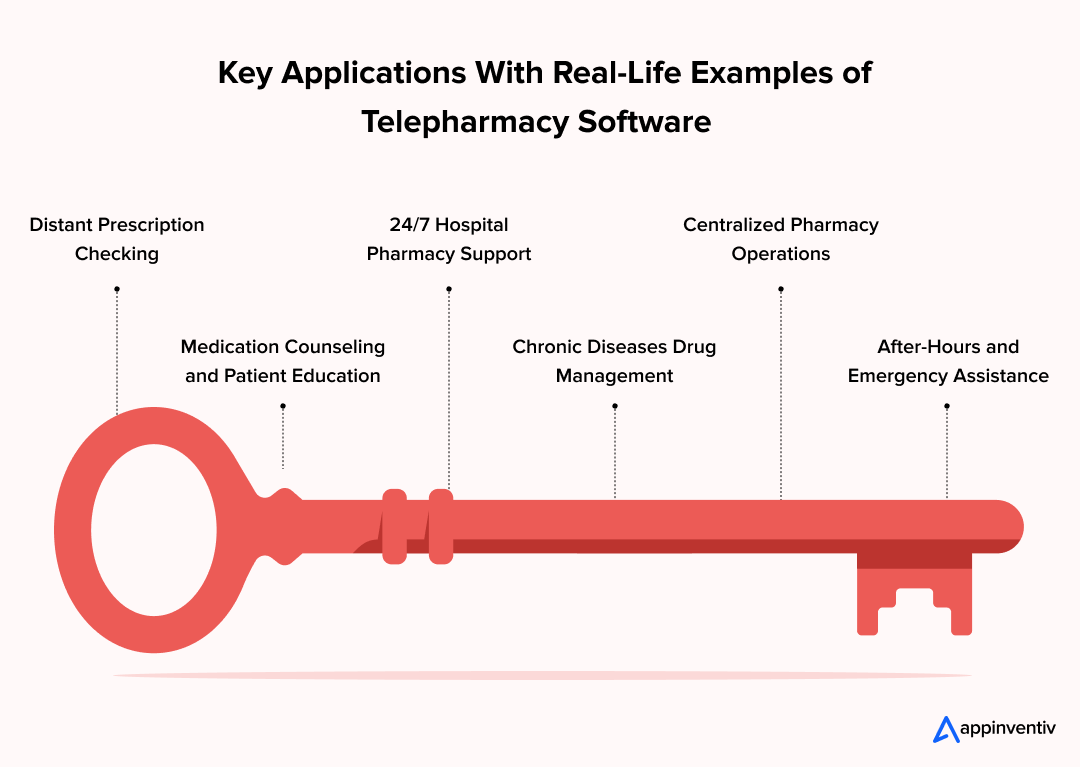
Distant Prescription Checking
The underserved or rural regions have a high risk of a shortage of pharmacists. By using telepharmacy software, it is possible to remotely check the prescription before dispensing with licensed professionals, lowering dispensing errors and regulatory compliance.
Example: The North Dakota Telepharmacy Project proved the effectiveness of this model, as it assisted over 80 rural pharmacies in remaining in business and also continued to be very safe.
Medication Counseling and Patient Education
Medication-related advice has been brought to patients living in remote communities because of virtual pharmacist consultations. These relationships enhance trust, enhance knowledge on drug use, and minimize the chances of nonadherence.
Example: PipelineRx, a leader in telepharmacy services in healthcare, offers remote clinical support and patient counseling services to hospitals in various states to assist healthcare organizations in extending the quality pharmacy services across geographical borders.
Appinventiv’s Insights
Leverage data from the telepharmacy platform to tailor counseling sessions. By analyzing prescription history, adherence patterns, and patient questions, pharmacists can provide more relevant guidance, anticipate challenges, and strengthen patient engagement over time.
24/7 Hospital Pharmacy Support
Custom telepharmacy software development, which links clinical pharmacists with off-site verification centres, is a benefit to the hospitals that require round-the-clock coverage. This model ensures that prescriptions are checked on time, even during overnight shifts.
Example: ePharmacy Services offered by Avera Health offer 24 hours of remote validation to over 100 rural hospitals, which enhances turnaround time and patient care safety.
Chronic Diseases Drug Management
Frequent dosage monitoring is usually necessary in patients who have to manage long-term conditions such as hypertension or diabetes. Telepharmacy medication compliance solutions are a set of platforms that allow pharmacists to monitor adherence, provide reminders, and modify therapy plans remotely.
Example: Medication Therapy Management (MTM) programs are U.S.-based programs that use telepharmacy to minimize noncompliance and improve chronic disease results by regularly conducting pharmacist follow-ups.
Our team at Appinventiv built DiabeticU, a great diabetes management app that works easily with wearable devices; it gives users personalized meal plans, exercise routines, medication tracking, and monitors blood sugar.
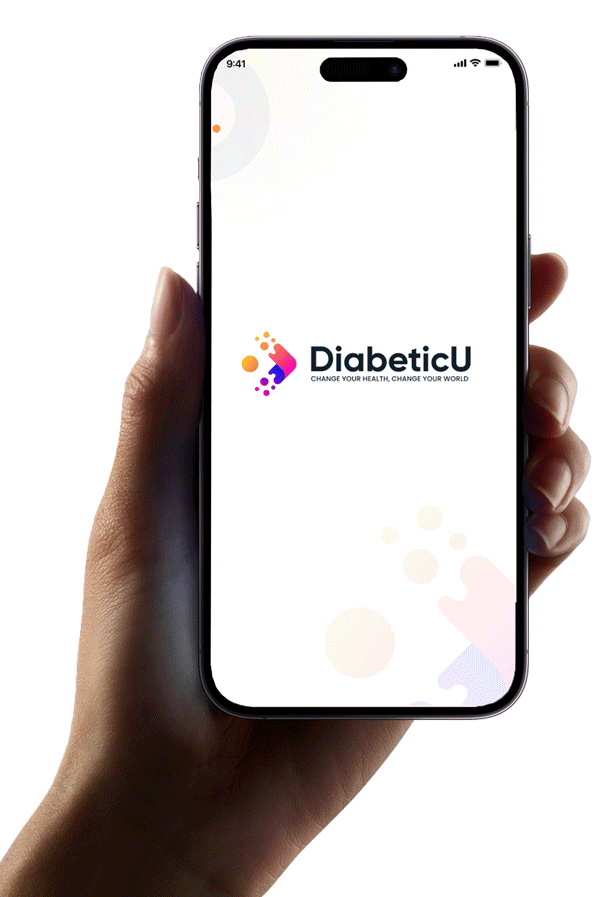
By using real-time data with specific health insights, DiabeticU changed how people manage diabetes, boosting user health and making their overall quality of life much better.
Centralized Pharmacy Operations
The centralized telepharmacy systems are applied by large healthcare systems and retail pharmacy chains to streamline their workflow. They enable real-time tracking of inventory, standard reporting, and shared pharmacist resources among various locations.
Example: Banner Health adopted a centralized telepharmacy model and optimized prescription checking, enhanced efficiency, and reduced the costs of operation.
After-Hours and Emergency Assistance
Smaller facilities with the inability to sustain overnight staffing employ telepharmacy systems to guarantee 24/7 patient care. Urgent prescription checks and medication reviews are also handled when remote pharmacists are not in regular hours.
Example: CHRISTUS Health in Texas implements remote telepharmacy systems to guarantee twenty-four-hour pharmacist availability and compliance with all care units.
Telepharmacy Software Development Journey
The telepharmacy software development process is a complex journey that unites the technologies, regulations, and user-centred design. The stages make the platform secure, efficient, and able to improve the care of the patients and address the regulatory standards.
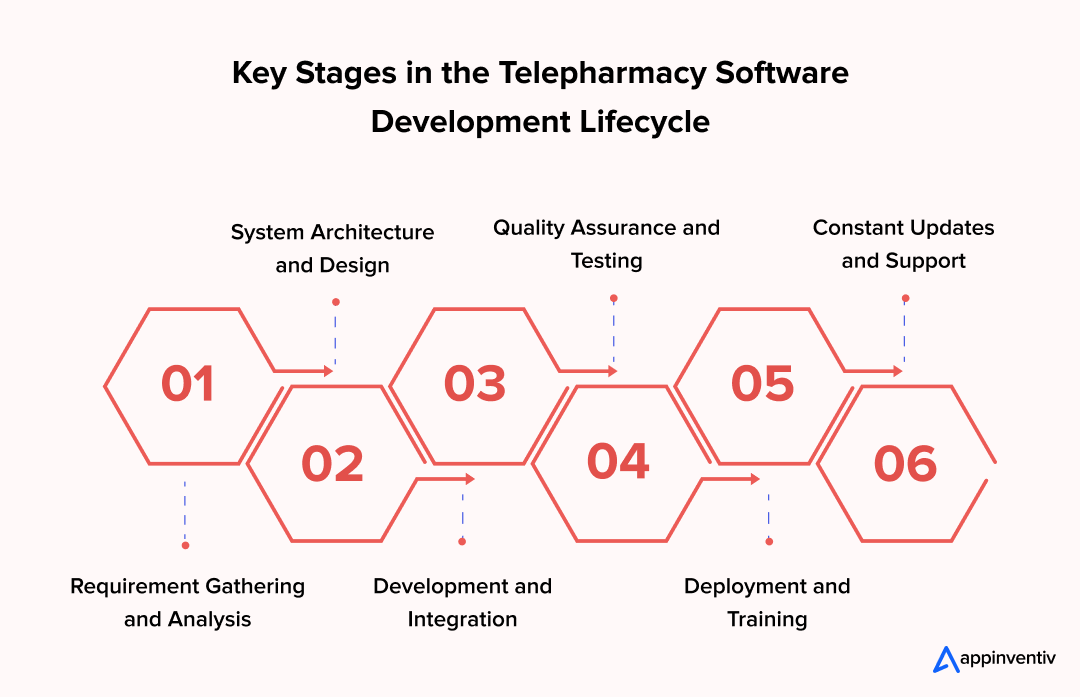
Requirement Gathering and Analysis
The first step is the intensive involvement of stakeholders, such as pharmacists, healthcare providers, and patients, to determine the workflow, pain points, and vital functionalities. It should also include a good knowledge of local and international healthcare policies.
Spending time in this area enables the teams to design custom telepharmacy software development that can be provided to meet the individual operation and clinical requirements to provide a solid base for the whole solution.
System Architecture and Design
The development of a robust system architecture will ensure that the platform can support multiple modules, including prescription management, virtual consultations, inventory tracking, and reporting dashboards. The main considerations include security, scalability, and performance.
An effective telepharmacy management system can be developed to enable coordination between pharmacists, healthcare providers, and patients in a smooth manner, which predetermines the effective long-term functioning.
Development and Integration
In the course of developing healthcare software in telepharmacy, such core features as video consultations, secure messaging, automated dispensing, and analytics are introduced. The stage is also aimed at integrating the software into the current healthcare systems, so that the patient data passes through an architectural seam.
The integration of the best practices enables developers to design an interoperable system that is accurate and consistent with clinical processes.
Quality Assurance and Testing
Testing is essential to ensure that the software works under various circumstances. Security checks, regulatory compliance audits, and user acceptance testing can be used to identify and correct issues prior to the launch.
Effective telepharmacy software integration services will ensure that the software is perfectly compatible with other systems to minimize the chances of errors in prescription handling, consultations, and reporting.
Deployment and Training
After the tests are finished, the platform is implemented in clinics, hospitals, or retail pharmacies. Pharmacist and staff training sessions are to allow the correct use of it and safety precautions to be taken.
With the help of organized onboarding, telepharmacy software solutions can be exploited to their maximum capacity, allowing the efficient functioning of the process and a comfortable user experience for both healthcare providers and patients.
Constant Updates and Support
Post-launch support plays a crucial role in maintaining security, introducing new functionality, and complying with evolving rules and regulations. Service reliability can be achieved through frequent updates and monitoring.
Through long-term maintenance, telepharmacy Services in healthcare will be maintained, safe, and trusted both by the patients and the providers, which will continue to support the worth of the software in the healthcare ecosystem.
Let us help you create a secure, efficient platform that improves patient care and meets regulatory standards
Critical Challenges in Building Telepharmacy Software and Strategies to Solve Them
Telepharmacy software development must address a complex combination of technical, regulatory, and operational challenges. Let’s check some of these challenges in telepharmacy software development and solutions to tackle those.
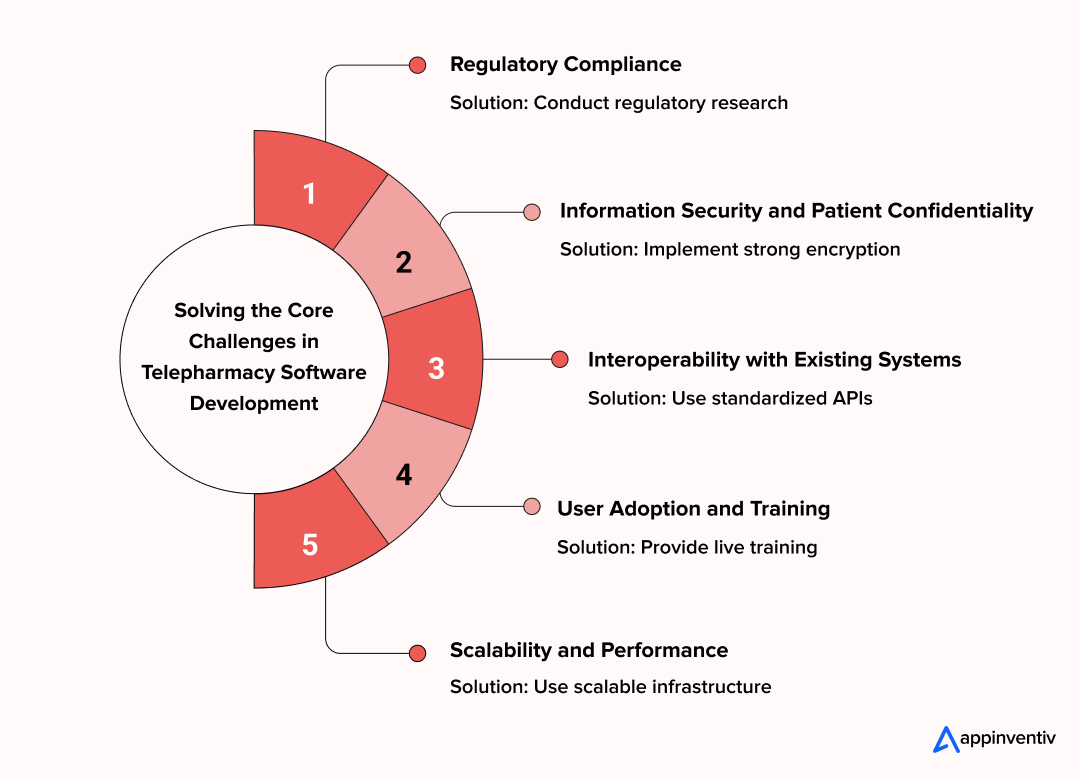
Regulatory Compliance
Challenge: Telepharmacy platforms should adhere to stringent healthcare policies like HIPAA or other telehealth policies in the state. Failure to comply may lead to fines, delays, or legal issues.
Solution: Start by conducting extensive regulatory research in planning and adhering to the major healthcare compliances. Embark on enforcing compliance checkpoints and liaising with legal and clinical advisors. Adhering to this strategy will make your telepharmacy medication compliance solutions not only patient but also legally compliant.
Information Security and Patient Confidentiality
Challenge: The management of sensitive patient data puts the software at risk of cyberattacks and possible attacks. Any negligence may ruin trust and break the rules.
Solution: Strong encryption protocols, secure authentication, and role-based access control. Periodic security checks and compliance with global standards are effective to ensure data safety of patients and confidence in your platform.
Interoperability with Existing Systems
Challenge: Telepharmacy software is required to integrate with EHR/EMR, inventory, and payment gateways, which may be technically complicated. Lack of consistent integration may affect work processes and efficiency.
Solution: Standardized APIs and modular architecture to make it easier to integrate. The use of experienced developers will make the telepharmacy software development services smooth and reliable, as well as interoperable with other healthcare systems.
User Adoption and Training
Challenge: Pharmacists, clinicians, and patients may struggle to implement new digital platforms without appropriate counseling, which could limit the software’s effectiveness.
Solution: Live onboarding and training, user manuals. The creation of a user-friendly interface and well-organized working processes can also boost adoption levels, making custom telepharmacy software development more efficient and effective.
Scalability and Performance
Challenge: Telepharmacy systems have to manage different workloads, including the peak prescription numbers and numerous simultaneous consultations, and still ensure performance.
Solution: Deploy a scalable cloud infrastructure and do stress testing with real-world conditions. This makes this platform able to scale alongside the organization without compromising performance and reliability.
Build a Reliable Telepharmacy Platform with Appinventiv
The future of telepharmacy is being shaped by technologies like artificial intelligence, machine learning, cloud computing, blockchain, IoT devices, and data analytics. These tools are transforming pharmacy services in significant ways, enabling real-time prescription verification, predicting patient adherence to medication plans, automating inventory management, and ensuring the secure sharing of patient data.
AI helps pharmacists see what patients might need ahead of time. Blockchain maintains data integrity and keeps everything compliant. IoT devices enable the remote, ongoing monitoring of patient health.
At Appinventiv, we turn these ideas into working solutions. Our experience in telepharmacy software development means we build platforms that are secure, scalable, and integrate modern technology without problems. From the first concept to final deployment, our healthcare software development services are about improving patient care, making pharmacy operations run better, and producing results that can be tracked.
Our solid healthcare portfolio demonstrates this well. Projects like Soniphi, Health-e-People, and DiabeticU reflect our ability to create digital solutions for different healthcare challenges. To witness the real impact of our work, watch our client testimonial video showcasing improved patient outcomes and enhanced operational efficiency.
Telepharmacy is moving quickly, and with Appinventiv as your telemedicine software development partner, your platform can keep up.
Contact us today to discuss how we can bring your telepharmacy vision to life.
FAQs
Q. How does telepharmacy integrate with the existing pharmacy management system?
A. Telepharmacy solutions interface with current pharmacy management systems via standardised APIs and modular architecture. This integration enables patient records, prescription history, inventory information, and billing information to be accessed on a real-time basis, ensuring that there will be smooth workflows between the in-store and remote activities of the pharmacy.
Q. How do telepharmacy systems ensure data security and compliance with regulatory standards?
A. Telepharmacy software employs encryption, secure authentication, role-based access, and audit trails to safeguard sensitive patient data. Conformance is ensured by complying with health-related regulations on the regional and international levels, including HIPAA or local telehealth legislations, and by integrating security checks into the development lifecycle.
Q. What pharmacy services can be effectively delivered through telepharmacy?
A. Telepharmacy allows offering a broad spectrum of services such as online patient consultations, prescription and verification, pharmacological counselling, automated dispensing, monitoring of chronic diseases, and monitoring of patient adherence. It enables pharmacists to provide high-quality care at a distance without compromising safety and accuracy.
Q. How long will it take to build a telepharmacy software?
A. The schedule is based on the complexity of features, integration needs, and compliance. The average time that it takes to design, develop, test, and deploy a strong telepharmacy solution is 4-9 months, not to mention the extra time that can be taken to train and comply with regulatory requirements.
Q. How much does it cost to build a telepharmacy software development?
A. The telepharmacy software development cost differs based on the features and customizations, as well as the compliance requirements of the platform. The simplest telepharmacy system might cost in the range of $30,000 – $150,000, and a highly customized, enterprise-level platform with multi-site coverage and analytics should cost $150,000 – $300,000 or more. The maintenance and updates, as well as compliance-related upgrades, are also to be mentioned.
Q. What are some of the emerging trends in telepharmacy software development?
A. Here are some of the emerging trends in custom telepharmacy software development:
AI-Based Medication Management: AI is useful to forecast adherence, identify possible drug interactions, and provide individualized counseling to achieve safer and more effective care.
Remote Patient Monitoring (RPM) Integration: Wearable devices and home sensors allow real-time patient information to be sent to the pharmacists, and proactive interventions are possible.
Data Security Through Blockchain: Decentralized ledgers protect patient records, ensuring compliance and building trust in telepharmacy services.
Cloud-Based Systems: Cloud infrastructure enables scalable, flexible solutions to telepharmacy and stress-free integration of telepharmacy systems with existing healthcare platforms.
New Regulatory Support: New regulations and DEA policies on telepharmacy consultations and dispensing will help expand the use of telepharmacy and its capacity to provide more services.


- In just 2 mins you will get a response
- Your idea is 100% protected by our Non Disclosure Agreement.
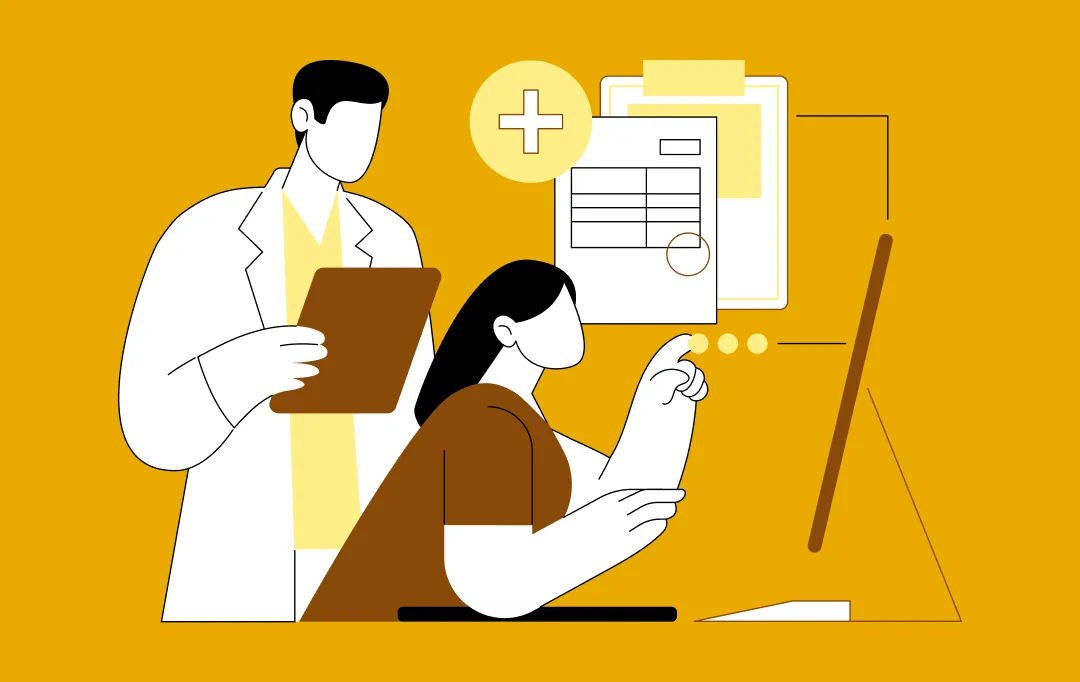
How Much Does It Cost to Build a Healthcare App in Saudi Arabia? All You Need to Know
Key takeaways: Healthcare app costs in Saudi Arabia range from 112,500 SAR to 2,250,000+ SAR based on size and complexity. The type of app you build matters more to cost than anything else. Compliance, security, and scalability are built into the cost, not add-ons. Development and testing consume the largest share of the budget. Hidden…
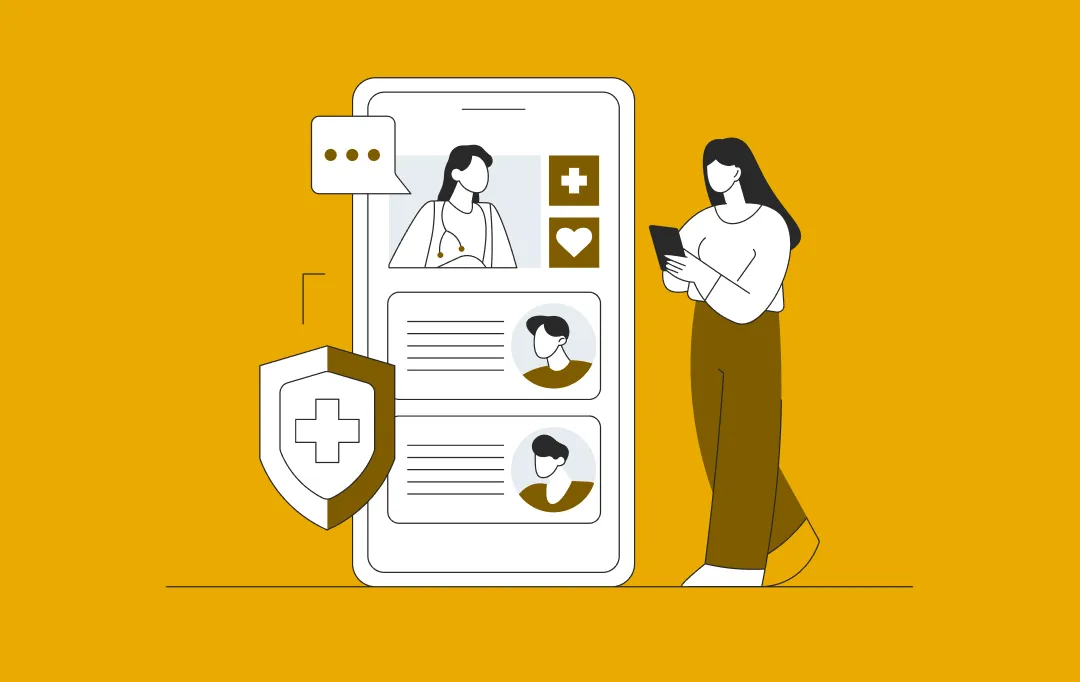
How Prescriptive Analytics Is Shaping the Future of Healthcare Management
A healthcare business doesn’t fall behind because its teams lack skill. It falls behind when decisions take too long. Bed allocation runs on yesterday’s data. Procurement reacts only when shortages hit. Care managers step in after a patient is already at risk. And leadership gets a picture of what’s happening only after the quarter closes,…
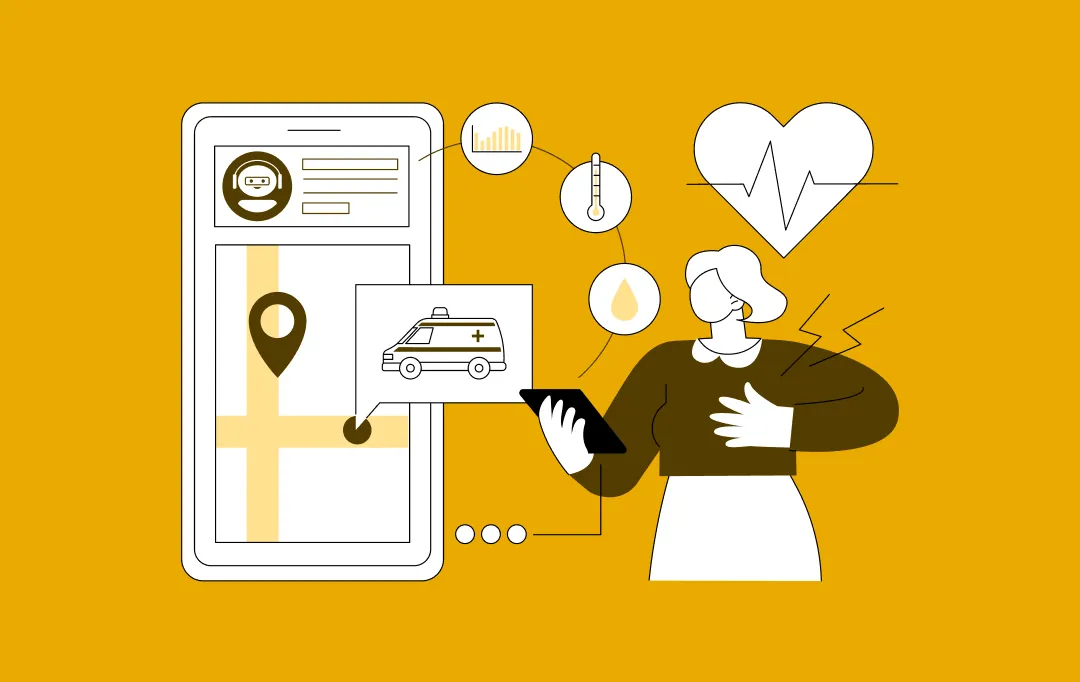
How to Build an Urgent Care App? A Step-by-Step Process, Features and Costs
Key takeaways: With more people turning to digital healthcare, the urgent care app market is expected to touch $3.1 billion by 2024 and continue growing fast through 2030. Apps that offer easy scheduling, video consultations, EHR access, and quick insurance handling tend to attract more users and keep them coming back. Developing an urgent care…











